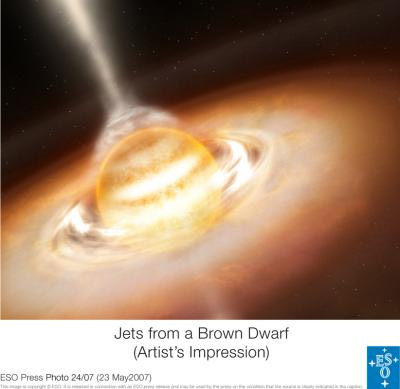Astronomers at the European Southern Observatory (ESO) VLT have found jets coming out from a 24 Jupiter-mass brown dwarf, or failed star, similar to the jets that are found coming out of young, but fully fledged stars.
These jets, or "outflows" as they are known, are ubiquitous in the universe, having been seen on everything from galactic cores, right down to new born stars. But this particular brown dwarf is the smallest ever object to be confirmed as having outflows.
"This leads us to the tantalising prospect that young giant planets could also be associated with outflows," says Emma Whelan, the lead-author of the paper reporting the results.

Indeed, the research team suggests that the jets could be driven by gas-giant planets as "small" as Jupiter.
The observation itself was tricky: brown dwarves do not light up the sky like a normal young star, so the jets are not bright enough to be seen directly. As well as being relatively dim, they are small. Although in reality they stretch for about a billion km from the failed star, they appear to us on Earth to be the same size as a two Euro coin seen at a distance of 40km.
To make their observations, the astronomers used a technique known as spectro-astrometry, based on high resolution spectra taken with UVES on the VLT (Very Large Telescope).
"Discoveries like these are purely reliant on excellent telescopes and instruments, such as the VLT," says Whelan.
"Our result also highlights the incredible level of quality which is available today to astronomers: the first telescopes built by Galileo were used to observe the moons of Jupiter. Today, the largest ground-based telescopes can be used to observe a Jupiter size object at a distance of 200 light years and find it has outflows." ®
